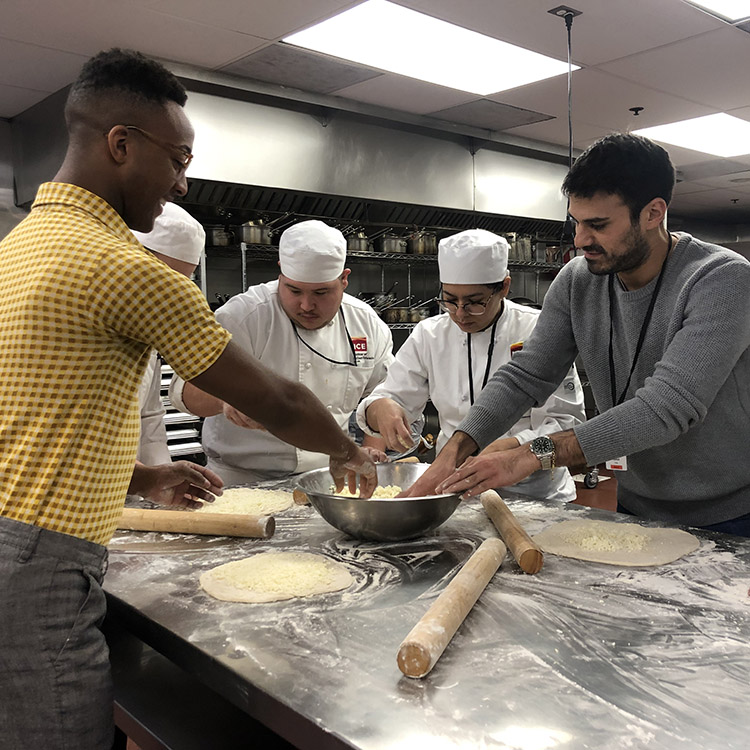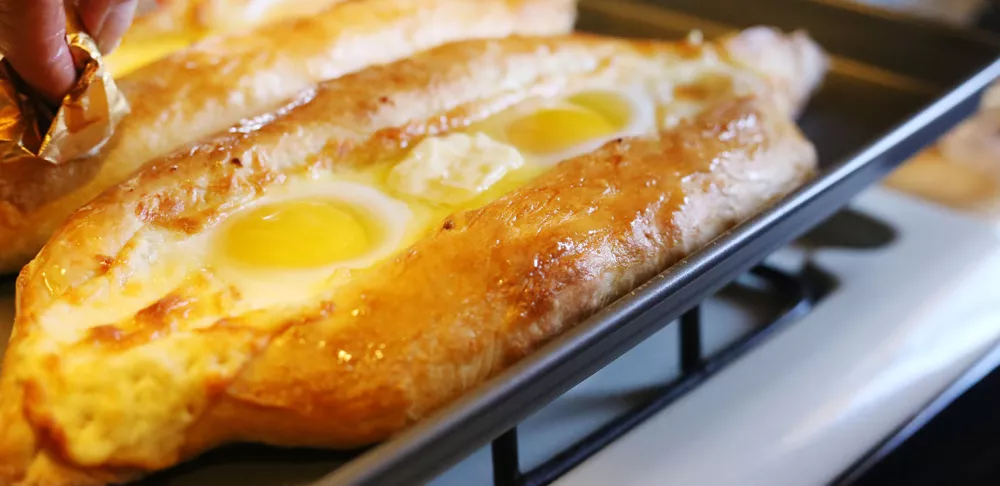Georgian food may not have had its moment in the sun yet, but the country’s signature bread is starting to make its rounds on social media, shining a spotlight on the former Soviet Socialist Republic’s cuisine and culture.
Perhaps it’s that money shot of the bright orange, runny yolks blended into a pool of cheese, that has promoted one of the most addictive and unique bread variations in recent [social media] memory. But there’s more to the story of khachapuri than what you see in those crave-inducing photos.
Khachapuri is a combination of two Georgian words: khacho, meaning cheese curds, and puri, meaning bread. Each region in Georgia has its own iteration of khachapuri, and the Adjaruli version is gaining popularity in American food cities like Los Angeles where there is a large population from Georgia’s neighboring country, Armenia. The Adjaruli hails from the Black Sea region of Adjara and is boat-shaped given the maritime culture. The bread is served as a precursor to any meal with the exception of dinner.
Elmira Avetian, an instructor with The League of Kitchens — a collective of immigrant cooks in New York and Los Angeles — was born in Georgia’s capital city of Tbilisi and lived in Armenia before moving to Los Angeles. Elmira visited ICE’s LA campus and shared khachapuri with students, saying the cheesy bread is the centerpiece at Georgian gatherings as it is customarily served to welcome friends and family into one’s home.

After baking the raw cheese enveloped in the dough in a steam-filled oven, it is a real crowd-pleaser with its tableside theatrics of eggs cracked on top of the cheese. Then the bread is returned to the oven for a few minutes to set while still runny. Next, cold butter is added and stirred very quickly with a fork to create an ocean of ooey gooey cheese mixture. The boat-shaped bread is cut into small pieces around the perimeter to pull and dip — khachapuri is best eaten with your hands.
Make this Georgian staple at home to wow whomever you're breaking bread with.
Adjaruli Khachapuri (Boat-Shaped Georgian Cheese Bread)
courtesy of Elmira Avetian and The League of Kitchens
Yields 2 khachapuri, serves 4

Ingredients
For the dough:
- 2 cups all-purpose flour, sifted, plus more for dusting
- 1 teaspoon fine sea salt
- 1 teaspoon sugar
- 3/4 teaspoon rapid rise yeast
- 3/4 cup warm water
- 2 tablespoons sunflower oil
For the filling:
- 8 ounces sulguni cheese or mozzarella (see Cook’s Note)
- 8 ounces feta cheese
- 1 tablespoon all-purpose flour
- 3/4 cup whole milk
- 3 large eggs
- 2 tablespoons unsalted butter
Directions
For the dough:
- Put the sifted flour in a mixing bowl and add the salt, sugar and yeast. Mix with your hands to combine.
- Slowly pour in the warm water and mix with a spoon until a shaggy dough forms, about 5 minutes.
- Scrape down the sides of the bowl. Cover the bowl with plastic wrap and set the dough aside in a warm spot, such as on top of the stove, to rise for 15 minutes.
- Uncover and drizzle oil. Mix the oil into the dough with your hands, folding it over to coat all sides. The dough should feel slick and look shiny.
- Re-cover the bowl with plastic wrap and set aside in a warm spot. Let rise for 45 minutes to 1 hour, kneading twice at 15-minute intervals. The dough has finished proofing when it has doubled in size.
For the filling:
- Use the large holes of a box grater to grate the sulguni* cheese into a bowl, you should have 2 cups of shredded cheese.
- Do the same with the feta.
- Sprinkle the flour over the cheese and toss with your hands to evenly distribute.
- Pour in the milk and mix with your hands, squeezing the cheese together. The cheese should have the look and consistency of ricotta.
To form and bake:
- Dust a work surface or cutting board with flour. Unwrap the dough, put it on your floured work surface and dust the top with flour. Knead the dough with the heel of your hand, turning and folding it over several times to press it flat. Turn the dough slightly, fold it in half and rock into it again with the heels of your hands. Knead the dough for 5-10 minutes until it feels smooth and springy.
- Preheat the oven to 465 F. Pour 1 cup of hot water into a small baking pan and set on the floor of the oven – this will create a moist oven environment.
- Line a nonstick baking pan with wax paper.
- Cut the dough into two equal pieces, about 8 ounces each. Working with one piece at a time, roll the dough out with a floured rolling pin into an oblong shape, 9 inches long by 7 inches wide and a half-inch thick. You may also pull and stretch the dough with your hands.
- Carefully transfer the piece of dough to the prepared baking sheet.
- Spoon half of the cheese mixture on top of the dough, keeping a half-inch border all the way around. Spread the cheese evenly with the back of a tablespoon.
- Roll from the bottom up to enclose a portion of the filling and create a wall. Do the same thing on the top, rolling the dough down towards the center. Gently pinch and twist the left and right ends together to seal and pull outwards slightly to create a boat shape. Repeat with the remaining piece of dough and cheese.
- Beat 1 egg and brush it onto the dough.
- Place the khachapuri into the oven and bake until lightly golden, 15 to 20 minutes.
- Remove the khachapuri and the pan of water from the oven. Use a fork or spoon to make a small well in the center of each boat and crack one egg into each.
- Return the khachapuri to the oven and bake until the eggs have set, an additional 4 to 5 minutes. Lightly rub 1 tablespoon of the butter on and around the dough, and then drop the remaining into the melted cheese mixture.
To serve:
It is traditional to tear off pieces of the ends of the bread and mix the runny egg and melted cheese together for guests to dip the crust in the ooey gooey mixture.
*Sulguni is a mild, semi-firm Georgian cheese that is similar to mozzarella with a bit saltier and more sour flavor. It is sold in round discs and is not only a key ingredient in khachapuri, but also commonly eaten as table cheese during a Georgian meal. Sulguni is available online and in Eastern European grocery stores. Whole-milk mozzarella may be substituted, however, avoid using fresh mozzarella packed in water as it makes the dough soggy.
Learn more about international foods in ICE's Culinary Arts program in Los Angeles, or study Artisan Bread Baking in New York.




